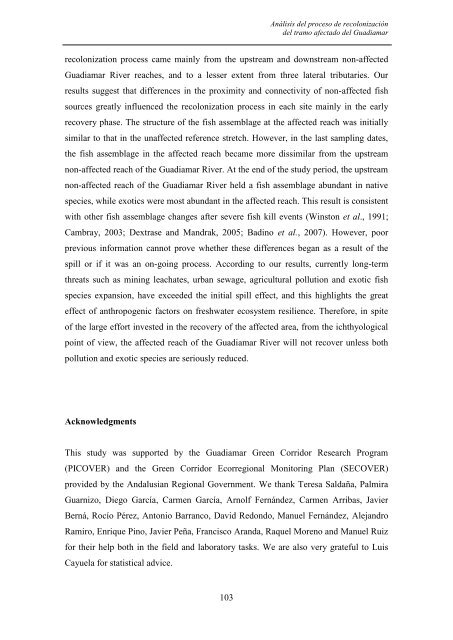las comunidades de peces del río guadiamar y el accidente minero ...
las comunidades de peces del río guadiamar y el accidente minero ...
las comunidades de peces del río guadiamar y el accidente minero ...
You also want an ePaper? Increase the reach of your titles
YUMPU automatically turns print PDFs into web optimized ePapers that Google loves.
Análisis <strong>de</strong>l proceso <strong>de</strong> recolonización<br />
<strong>de</strong>l tramo afectado <strong>de</strong>l Guadiamar<br />
recolonization process came mainly from the upstream and downstream non-affected<br />
Guadiamar River reaches, and to a lesser extent from three lateral tributaries. Our<br />
results suggest that differences in the proximity and connectivity of non-affected fish<br />
sources greatly influenced the recolonization process in each site mainly in the early<br />
recovery phase. The structure of the fish assemblage at the affected reach was initially<br />
similar to that in the unaffected reference stretch. However, in the <strong>las</strong>t sampling dates,<br />
the fish assemblage in the affected reach became more dissimilar from the upstream<br />
non-affected reach of the Guadiamar River. At the end of the study period, the upstream<br />
non-affected reach of the Guadiamar River h<strong>el</strong>d a fish assemblage abundant in native<br />
species, while exotics were most abundant in the affected reach. This result is consistent<br />
with other fish assemblage changes after severe fish kill events (Winston et al., 1991;<br />
Cambray, 2003; Dextrase and Mandrak, 2005; Badino et al., 2007). However, poor<br />
previous information cannot prove whether these differences began as a result of the<br />
spill or if it was an on-going process. According to our results, currently long-term<br />
threats such as mining leachates, urban sewage, agricultural pollution and exotic fish<br />
species expansion, have excee<strong>de</strong>d the initial spill effect, and this highlights the great<br />
effect of anthropogenic factors on freshwater ecosystem resilience. Therefore, in spite<br />
of the large effort invested in the recovery of the affected area, from the ichthyological<br />
point of view, the affected reach of the Guadiamar River will not recover unless both<br />
pollution and exotic species are seriously reduced.<br />
Acknowledgments<br />
This study was supported by the Guadiamar Green Corridor Research Program<br />
(PICOVER) and the Green Corridor Ecorregional Monitoring Plan (SECOVER)<br />
provi<strong>de</strong>d by the Andalusian Regional Government. We thank Teresa Saldaña, Palmira<br />
Guarnizo, Diego García, Carmen García, Arnolf Fernán<strong>de</strong>z, Carmen Arribas, Javier<br />
Berná, Rocío Pérez, Antonio Barranco, David Redondo, Manu<strong>el</strong> Fernán<strong>de</strong>z, Alejandro<br />
Ramiro, Enrique Pino, Javier Peña, Francisco Aranda, Raqu<strong>el</strong> Moreno and Manu<strong>el</strong> Ruiz<br />
for their h<strong>el</strong>p both in the fi<strong>el</strong>d and laboratory tasks. We are also very grateful to Luis<br />
Cayu<strong>el</strong>a for statistical advice.<br />
103

















